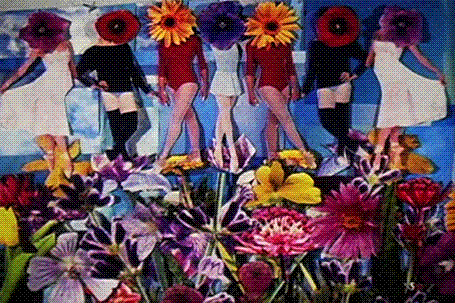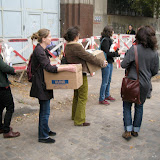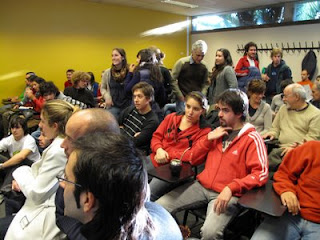
1˚ día
We arrived at the Museo del Cine in the late morning. A slightly overcast but pleasant day. The museum is on the 2˚ floor of a building on a short street named for José Aarón Salmún Feijóo (a nineteen-year-old who, in 1945, was killed while taking food to university students protesting the government).
Some major reconstruction was going on in the front of the building and throughout the ground floor. It was more amusing than odd to

see the faces of the construction men bewildered by the sight of nine women (and me) lugging heavy suitcases and equipment across the torn-up walkway and up two flights of stairs. A security guard came to me at the end of the line and asked what was happening. "Trabajamos con la directora del Museo de Cine," I said. "¿Segundo piso?" he asked. "Sí, señor." "OK."
The electricity was off when we arrived. We made our way through some dark corridors into a sunlit office, where we began to unpack all of the supplies we muled in. Much of it was donated, some of it bought with project funding. A few hundred 16mm and 35mm film cores (which we soon learned are called tacos here). Hot splicers, splicing tape, white leader, split reels, synch blocks, a shrinkage gauge, marking pens, artist tape, film cleaning cloths, gloves (cotton and nitrile), work aprons, AD test strips, cans of molecular sieves, archival cans, three pairs of rewinds, and a bunch of small tools and supplies that the Museo's paper conservators needed.
Paula introduced us to members of the staff throughout the day. They greeted us warmly (usually with a kiss on the cheek) and were happy to see the supplies arrive. It must have been a bit strange for them to see such an entourage of film archivists descend upon the Museo, an institution that has been "temporarily" relocated in this warehouse-like building for four years. A few of our group speak some Spanish and a few of the staff speak English well. Our interaction works well, due largely to having three highly fluent translators, each with roots in Buenos Aires and much time in New York: Paula, the museum director; her NYU classmate from 2004-06, Natalia Fidelholtz; and Daniela Bajar, who recently got her master's degree in Cinema Studies at NYU and has been active with the Orphan Film Symposium. New graduate of the MIAP program Kimberly Tarr has been to Argentina before and speaks some Spanish. Alice Moscoso from NYU Libraries takes to the local castellano adeptly, with her fluency in Italian, French, and English. Hopefully, the communication bridge is firm enough to make us not appear to be a bunch of invasive northerners.
The building is surprisingly large and the staff subdivided into several departments. Paula spends the better part of the day taking us on a tour of all the spaces. At each station we get information from the staff. Much of the museum is simply storage space for the 65,000 or so cans of film. High shelves, mostly filled. Some of the subcollections are in cans that are quite rusty. Most of the films need to be put on cores and transferred to better cans. Fortunately, at the far end of the building there is a large room with hundreds of slightly used 35mm cans. All appear to be from the local film laboratory, Cinecolor.
We learn of the primary collections owned by the museum. The personal collection of film critic Manuel Peña Rodriguez, who collected prints and negatives during the 1920s through the 60s, has become the famous part of the holdings. Paula, along with Fernando Peña, identified the thought-lost director's cut of Fritz Lang's Metropolis (1927) last year. Just last week the Museo and the city's ministry of culture signed an agreement with the Murnau Foundation to have the German archive add the rediscovered footage (about 20 minutes) to its previously definitive restoration of the silent cinema landmark. For those interested in archival issues and/or film history, the rediscovery of a canonized and definitively German film in an archive in far-off Argentina -- an archive not previously part of the international conversation within the profession -- this event is a reminder of how much we do not know. There is much unchartered territory in the archives, and in other places outside of libraries, archives, and museums. I think it's safe to say something like this: most films produced no longer exist; most extant films are not in film archives; most films held by archives are not yet preserved. And we haven't even addressed video.
Beyond the "Metropolis collection," the Museo del Cine has a few hundred cans donated by the U.S. Navy in the 1960s; a set of silent educational films produced by Gaumont, donated by the city's prestigious Colégio Nacional; animated films from an Argentinean company called Cinepa, dating from the 1950s and 60s; a run of Argentinean newsreels (1930-70s) and miscellaneous international newsreels; y muchas más. In our walk-through today we saw 8mm and Super8 films, a boxful of 9.5mm film cartridges, acres and acres of 16mm material, a 28mm projector, and 35mm feature films ranging from the conspicuously labeled Fuckland (a 2000 comedy set in the Falkland Islands after the unsuccessful war with the British to reclaim the Malvinas for Argentina in 1982) to eight complete Spanish-subtitled prints of Robert Altman's Prêt-à-Porter [?].
The museum also has a few thousand posters from throughout the twentieth century, along with stills, drawings, props, lobby displays, and an extensive set of movie costumes. Oh, and a very exciting collection of camera, projectors and other motion picture equipment. The pink purse-sized Zeiss-Ikon 8mm projector was a popular attraction. In the back of the room on top of a shelf sat nothing less than Lumière cinemátographe No. 4 [!].
You get the idea. A vast set of interesting material, much of it unique and much of it unidentified.
What to do first?
After a round of empanadas and coffees, we divided up into teams. One group of three worked on the Gaumont educational film collection. We started with a list of about 150 titles, typed in Spanish at the time of the 1988 donation. Were the film prints (all but one mudo) titled and intertitled in Spanish? French? both? Alice Moscoso selected one of the interesting sounding titles, which the inventory refers to as La Enseñanza del Dibujo por el Cine (two reels, 35mm, safety print, ca. 1920s). Putting the print on one of the few operational inspection stations, Alice found no Spanish text at all. The head title printed on the film is L'Enseignement du Dessin par le Cinema. Preceding this title card is a separate one: La Methode de Monsieur Adrien Bruneau, Inspecteur de l'Enseignement Artistique de la Ville de Paris. Howard Besser did a quick Internet search or Adrien Bruneau and found that he was noted for teaching drawing using motion pictures, starting in the late teens. Perhaps this print is not unique. But it is in beautiful shape, from what we can tell so far. Reddish tint, if I recall correctly. Perhaps Gaumont, which is still in business of course, or a French archive has equal or better material of this work, perhaps not. Even before that fact is established, however, historical research could tell us much about how these French-language films were used in the elite Colégio and for how long.
Two more observations gleaned from our very brief dip into this collection. Listed on the inspection sheet are a pair of two-reel 35mm films that are not Gaumont productions. Tomorrow we hope to see if the prints are in the collection and if so in what condition. One is entitled Colégio Nacional Buenos Aires -- Año 1917 and the other Colégio Nacional Buenos Aires, Año 1923. The staff tell us that these were filmed in those years by Pablo Ducros Hicken -- the collector of cameras for whom the Museo del Cine is named. I am waiting with anticipation to see the films of the high school shot in 1917 and '23.
An object lesson in archival practice for unexperienced hands like mine follows. Wanting to see if any of the Gaumont films might have been given Spanish titles for the Spanish-speaking markets, Howard thought it worth pulling the handful of titles on the inventory list that appear to have been shot in Argentina itself. One of those is listed as El Gaucho. No doubt a revealing, ninety-year-old cine-sketch of the Argentine cowboy-type, no? When the keeper of the films, Felipe Costa, brought out can no. 99, the label on the can read not El Gaucho but "El Cauchout." The film print itself bears the French head-title La Production du Caoutchouc en Indochine [The Production of Rubber in Indochina]. Lesson learned: What's in the catalog or finding aid is not necessarily what's on the container; and what's on the container may or may not be what's on the film/s inside.
Lot of photos being taken. More soon.













 NFPF's repatriation of American silent films from the National Film and Sound Archive of Australia
NFPF's repatriation of American silent films from the National Film and Sound Archive of Australia















